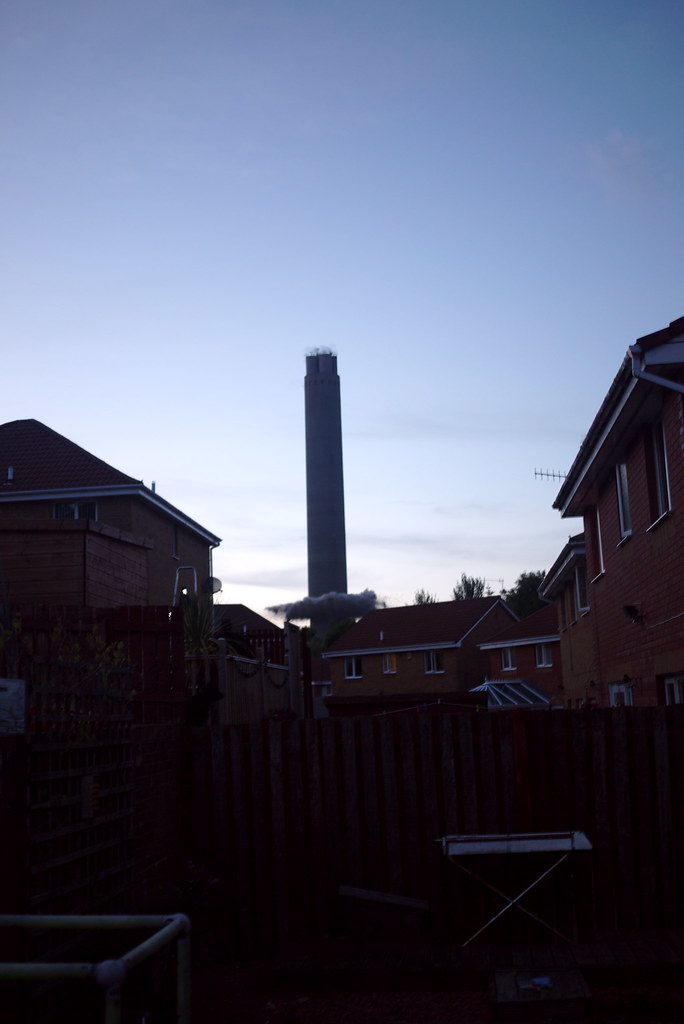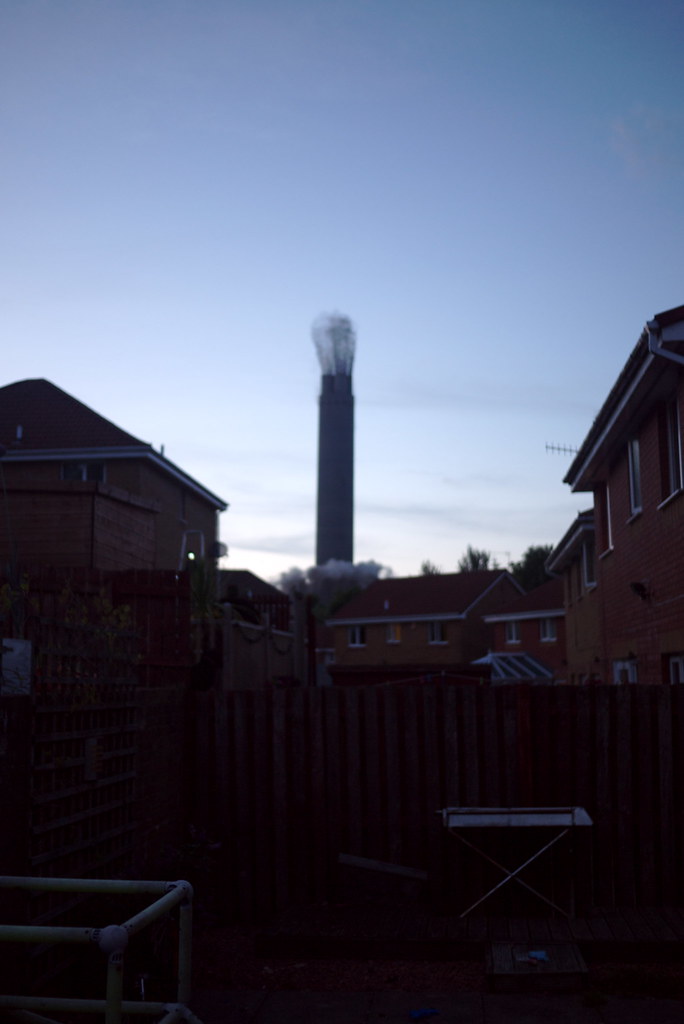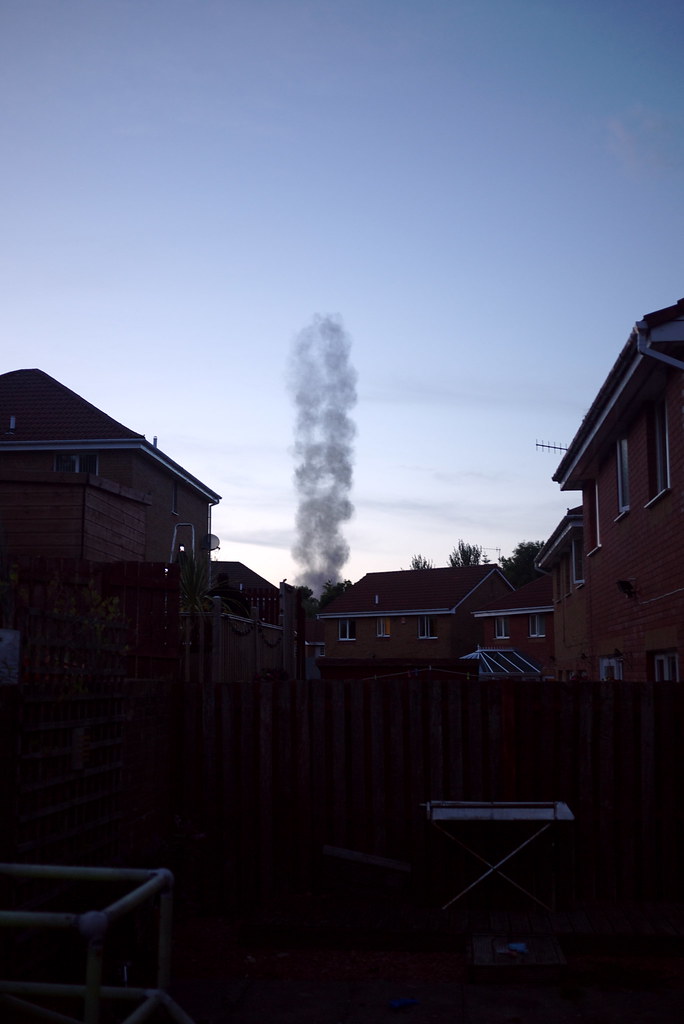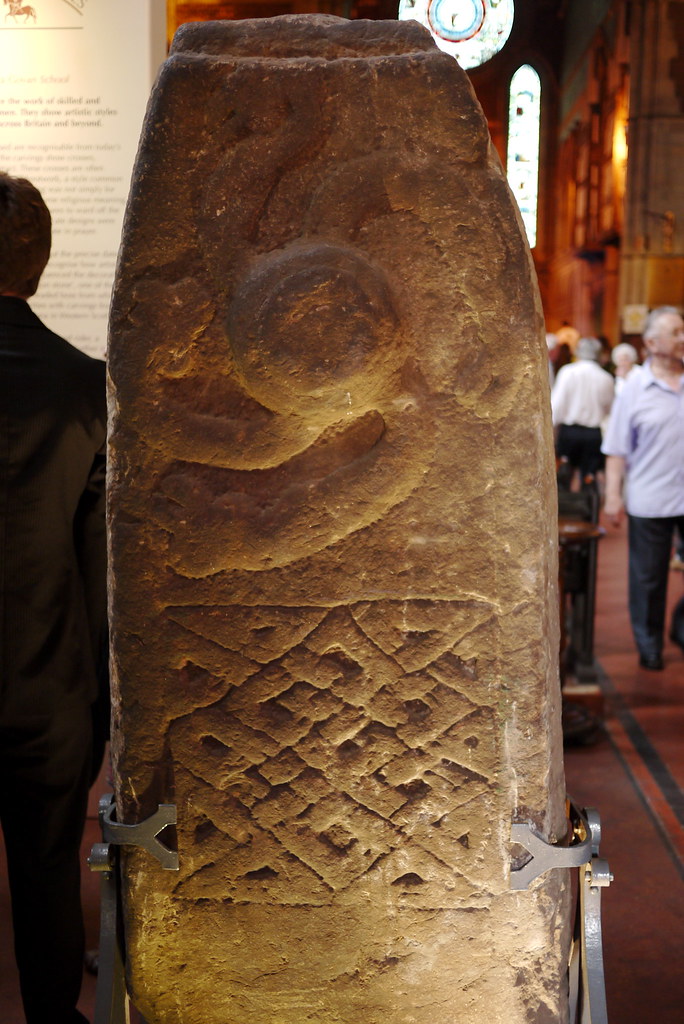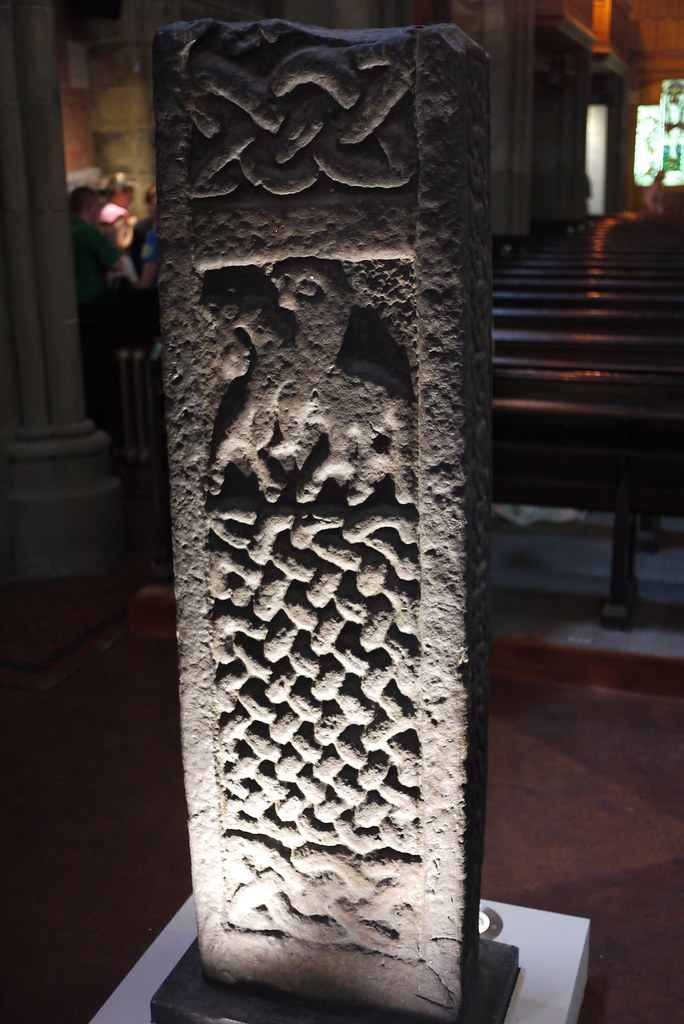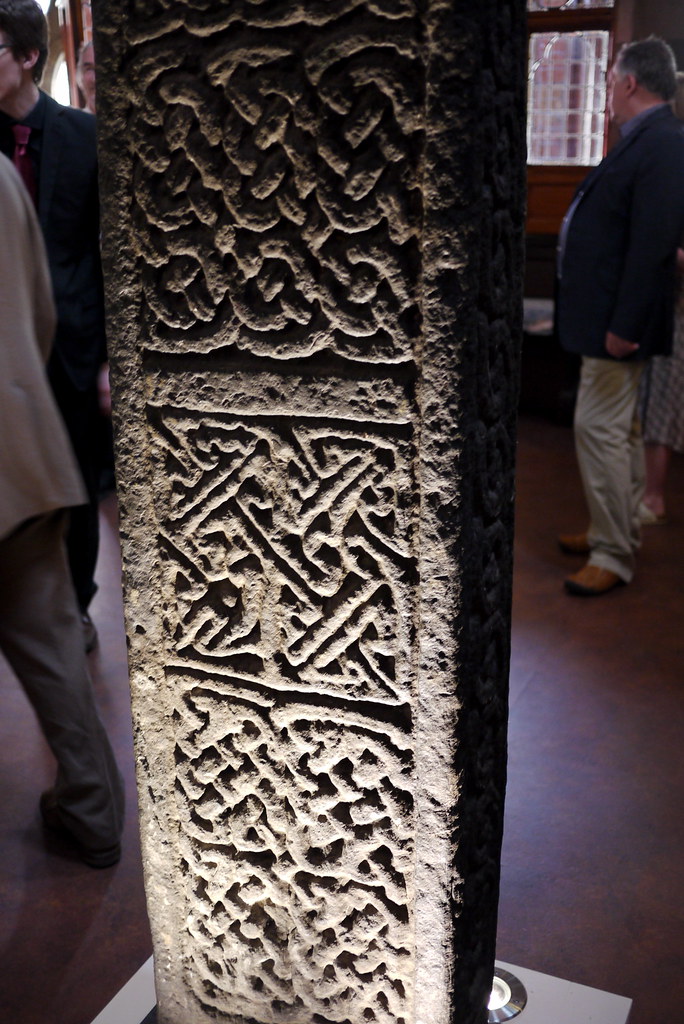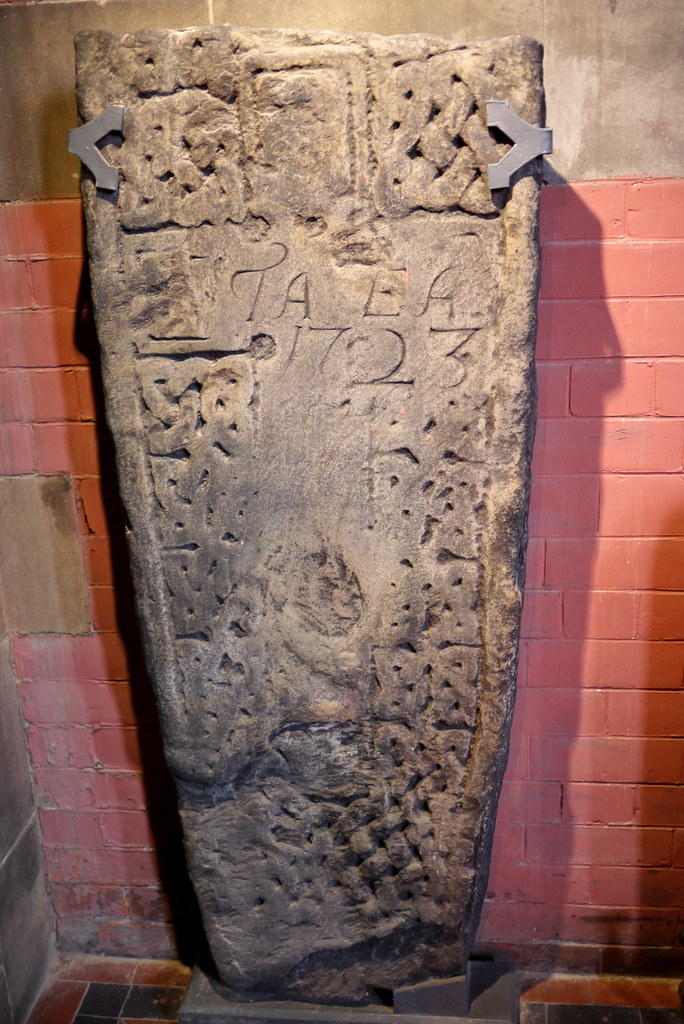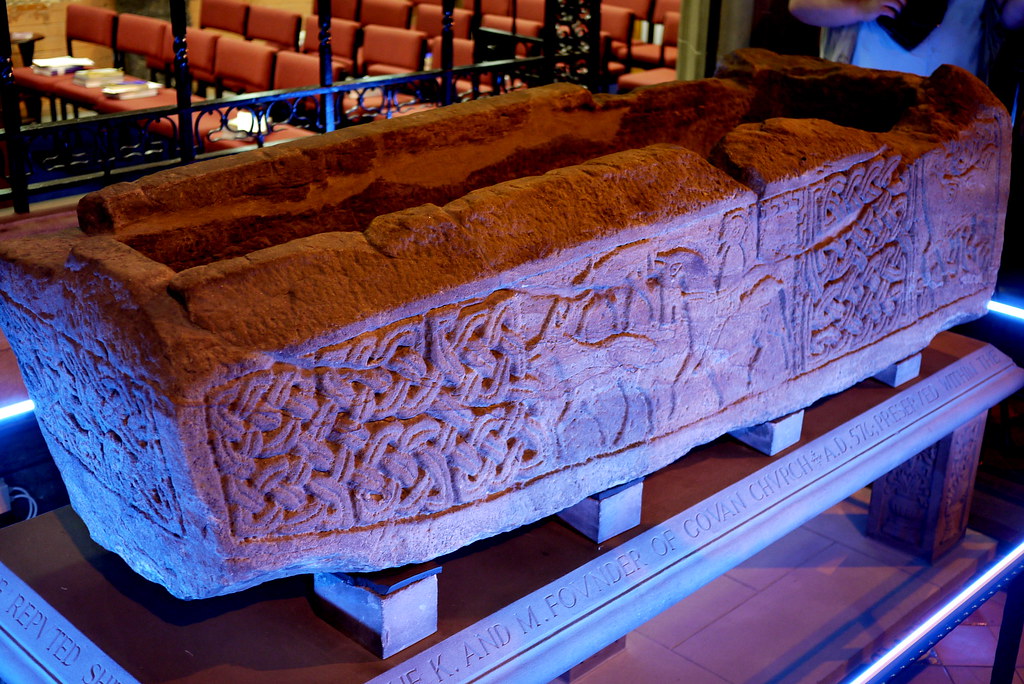Over the past year and then some, there has been ongoing work nearby to demolish the local power station, which was built in the 70s right before the oil prices crapped out globally and made it a financially pointless project. Although the site was completed, it never operated commercially and instead the chimney – the tallest independent structure in Scotland – served as a guide for sailors and pilots and generally creeped out the locals on foggy nights when the lights did things.
When we moved here, just over five years ago, we kinda thought of the chimney as a bit of a blot on the landscape. It was certainly hard to miss and being so close to it, the towering pile of concrete loomed over us and gave a general indicator of which direction the rain was coming in...But soon it became a familiar sign that we were home. It was a sigh of relief. My nephews, whenever they came to visit, would know they had arrived in Scotland because they could see the chimney (in spite of the fact that we're a couple of hundred miles north of the border or so...), so it was always a big thing to catch sight of.
But while the power station was testament to all that was smooth and shiny in the 70s, it was just taking up space in the 2000s, so it was decided that it had to go boom to make way for housing (naturally). Every now and then bits of the power station would get blown up but initially, when we moved to these parts, they were saying that the chimney couldn't be blown up because of the risk of tidal waves and so forth (it's right on the river side). Naturally someone with a brain and a mathematical head said otherwise, because going boom is exactly what happened in the end.
It was initially set to go at 5am as far as we were told, but for some reason it was changed to 10pm. I can only assume that the authorities figured that the locals being woken up at that time of a Sunday morning might be considered to be a bit anti-social (along with the authorities having to get up at that time too), so instead the evening it was. As such, the photos are a wee bit on the dark side, but it was twilight so there's only so much I can do. Sorry:
And now for the video (hopefully). Yes, those are my kids yelling:
Although naturally the Beeb had a better view.
Sunday 28 July 2013
Saturday 20 July 2013
Notes: Fosterage: Child-Rearing in Medieval Ireland
It's hot and I'm sunburnt. How about some notes?
Fosterage: Child-Rearing in Medieval Ireland
Bronagh Ní Chonaill
History Ireland Vol. 5 (1997)
This is a good article to read over if you're looking for a decent overview of how fosterage typically worked in early medieval Ireland and (arguably) before then as well, as it gives a good run down of how it worked under a variety of different circumstances – i.e. depending on your social status. There are also some incidental tidbits about how children were brought up during this time, the kinds of games they played, and so on, which offer some interesting points to ponder too.
Fosterage generally started at around the age of seven, though evidence of wet-nursing being commonplace suggests that it could start much earlier. Legally, seven was the age at which a child was determined to be capable of "learning and reason," and the foster-family would be in charge of the child's education and training for their future livelihood. Higher status children would learn things befitting someone of their rank, with girls learning fine embroidery skills and needlework, while boys learned about which way pointy end of a sword should go, and games of intellect like those "resembling draughts and chess." Horse riding could be taught if the child's family provided a horse but it wasn't necessary otherwise. Lower status boys would learn various aspects of manual labour and farming skills necessary to run their own households, while girls would learn cooking, grinding corn with a quern, weaving and herding.
The status of the child determined the kind of foods they were entitled to eat, and the colours of clothing they should wear. All children ate porridge, for example, but the flavours they were entitled to have added to it depended on their rank. Royal children could have honey with a porridge made of milk with wheat added; high ranking non-royals could have butter with a milk porridge, and everyone else could have salted porridge made with water. Meanwhile, only royal children could wear blue or purple, while aristocratic children could wear red, green and brown, and silver or gold brooches as befitted their status. Free-born children could wear black, yellow, white and "blay-coloured" clothes.
The foster-family was paid for their troubles, and the amount due to them depended again on the status of the child. Payment was usually in the form of cattle and clothing, and higher status children came with a higher fosterage fee than those of a lower status, reflecting the fact that they had greater entitlements. Because girls tended to come with a larger retinue in tow than boys did (probably because they needed more protection – protecting their reputation more than anything), the price for girls was always higher than that of a boy of the same status.
Pet dogs or cats are mentioned in legal texts, and games mentioned include hurley, wrestling, field games, piggy back games, and balls and hoops. One of the more interesting references, from a reminiscing poet, is to children imitating inauguration rites:
Some children were fostered out to several different families, especially children of higher status who were considered to be "desirable" in some way. Since fosterage was a good way of maintaining or creating social and political ties between families or even countries, children who were from politically important or influential families might be fostered out to several different families over the years for the benefit of the child's family as well as the foster-families. The foster-relationship would last as long as both sides had agreed, unless there were certain circumstances that meant it was necessary to cut the arrangement short – if the child was diseased or uncontrollable, say. Girls usually left fosterage at an earlier age than boys – at around fourteen. At that point they might return to their families, or more likely they were married off. Boys could remain in fosterage up until seventeen years of age, and at that point were legally responsible for their own crimes.
In addition to receiving a foster-fee, fosterage had lasting advantages to the foster-families. It created lasting ties between the two families, and in their later years the foster-parents were entitled to claim aid or maintenance from their foster-children, providing a kind of pension plan. It was these kind of advantages that saw the institution last for so long in Ireland – into the seventeenth century, certainly. On top of all that, in an often violent society, fosterage and the ties that bound certain families together helped to foster at least some sense of social and political stability. It might not have guaranteed it, but it certainly encouraged it.
Fosterage: Child-Rearing in Medieval Ireland
Bronagh Ní Chonaill
History Ireland Vol. 5 (1997)
This is a good article to read over if you're looking for a decent overview of how fosterage typically worked in early medieval Ireland and (arguably) before then as well, as it gives a good run down of how it worked under a variety of different circumstances – i.e. depending on your social status. There are also some incidental tidbits about how children were brought up during this time, the kinds of games they played, and so on, which offer some interesting points to ponder too.
Fosterage generally started at around the age of seven, though evidence of wet-nursing being commonplace suggests that it could start much earlier. Legally, seven was the age at which a child was determined to be capable of "learning and reason," and the foster-family would be in charge of the child's education and training for their future livelihood. Higher status children would learn things befitting someone of their rank, with girls learning fine embroidery skills and needlework, while boys learned about which way pointy end of a sword should go, and games of intellect like those "resembling draughts and chess." Horse riding could be taught if the child's family provided a horse but it wasn't necessary otherwise. Lower status boys would learn various aspects of manual labour and farming skills necessary to run their own households, while girls would learn cooking, grinding corn with a quern, weaving and herding.
The status of the child determined the kind of foods they were entitled to eat, and the colours of clothing they should wear. All children ate porridge, for example, but the flavours they were entitled to have added to it depended on their rank. Royal children could have honey with a porridge made of milk with wheat added; high ranking non-royals could have butter with a milk porridge, and everyone else could have salted porridge made with water. Meanwhile, only royal children could wear blue or purple, while aristocratic children could wear red, green and brown, and silver or gold brooches as befitted their status. Free-born children could wear black, yellow, white and "blay-coloured" clothes.
The foster-family was paid for their troubles, and the amount due to them depended again on the status of the child. Payment was usually in the form of cattle and clothing, and higher status children came with a higher fosterage fee than those of a lower status, reflecting the fact that they had greater entitlements. Because girls tended to come with a larger retinue in tow than boys did (probably because they needed more protection – protecting their reputation more than anything), the price for girls was always higher than that of a boy of the same status.
Pet dogs or cats are mentioned in legal texts, and games mentioned include hurley, wrestling, field games, piggy back games, and balls and hoops. One of the more interesting references, from a reminiscing poet, is to children imitating inauguration rites:
"...They would play at an imitation of an inauguration or homage ceremony, where a child was placed on a height with those remaining marching around him three times."The laws deal with who has rights and responsibilities when a child in fosterage either commits or is subject to a crime. The foster-father was usually responsible for a foster-child's crimes, unless he went to the child's natural father and proclaimed the child's criminal tendencies. If the foster-father was deemed to not be at fault for the child's behaviour, then the natural father would take on the responsibilities for the crimes and any necessary reparations (which were usually financial). If the father refused to pay for the crimes then the foster-family could simply return the child to the natural family and so protect themselves from further hassles. Otherwise, the foster-father could be held responsible for the child's future crimes, even for serious crimes like homicide. The foster-father could discipline the foster-child, but in no circumstances could they leave a blemish so there were tough limits to what they could do and the extremes they could go to. However, if a child was injured and received compensation for it, the foster-father was entitled to one-third of it unless the injury was caused by the foster-family's own negligence; then they had to compensate the child's natural family.(p30)
Some children were fostered out to several different families, especially children of higher status who were considered to be "desirable" in some way. Since fosterage was a good way of maintaining or creating social and political ties between families or even countries, children who were from politically important or influential families might be fostered out to several different families over the years for the benefit of the child's family as well as the foster-families. The foster-relationship would last as long as both sides had agreed, unless there were certain circumstances that meant it was necessary to cut the arrangement short – if the child was diseased or uncontrollable, say. Girls usually left fosterage at an earlier age than boys – at around fourteen. At that point they might return to their families, or more likely they were married off. Boys could remain in fosterage up until seventeen years of age, and at that point were legally responsible for their own crimes.
In addition to receiving a foster-fee, fosterage had lasting advantages to the foster-families. It created lasting ties between the two families, and in their later years the foster-parents were entitled to claim aid or maintenance from their foster-children, providing a kind of pension plan. It was these kind of advantages that saw the institution last for so long in Ireland – into the seventeenth century, certainly. On top of all that, in an often violent society, fosterage and the ties that bound certain families together helped to foster at least some sense of social and political stability. It might not have guaranteed it, but it certainly encouraged it.
Monday 15 July 2013
Hogbacks (Vikings, yarr!)
Last Thursday my mother-in-law kindly took the kids off my hands for the weekend, and offered me her place at the official launch of the new museum display for the hogback stones in Govan. Not being one to sniff at things like that, I gladly accepted and off I went. I only got slightly lost trying to find my way there.
Govan is a very old part of Glasgow and is home to a fine collection of carved stones, mostly dating to between the ninth-eleventh centuries. The stones are housed in the old parish church (which still functions as a place of worship, in addition to being museum), and the display is comprised of a number of recumbent slabs, crosses, the Viking hogbacks, and a fine sarcophagus that is thought to have been made for St Constantine, son of Cinaed mac Alpin.
There's an old brochure you can look at here, which gives details of a lot of the stones, though it's in a different layout to the one I saw so I presume it's from the previous display. Now, just as you go in, you see the 'Sun Stone':
Which takes its name from the assumption that the boss at the top is a sun with serpent rays spiralling out from it. The other side has a guy on a horse and a cross:
The Sun Stone is situated to another impressive stone, also with 'dude on a horse':
The back of which has some really intricate knotwork going on:
Remember those Pictish carvings from last month? I think the similarities with those are very striking on this one. Many of the other carvings are in bad shape because they spent many centuries lying around outdoors, not being looked after. A lot of them were also recycled from around the seventeenth century onwards, and after being repositioned to mark someone's grave they were often engraved to commemorate their new host. This one's a good example of the weathering that many have suffered, and the engraving:
The hogbacks are collected together off to one side, and they get their name from the slightly curved shape their tops have. They're actually thought to represent Viking longhouses rather than pigs, and you can find them in parts of northern England as well – wherever the Vikings went, really. Behold!
This one is one of the largest. There were some very young Vikings happily posing amongst some of the smaller ones, too:
(Yarrrr!)
Finally, before I overload this post with way too many pictures, there's the sarcophagus:
See also: The Canmore record for the site.
Govan is a very old part of Glasgow and is home to a fine collection of carved stones, mostly dating to between the ninth-eleventh centuries. The stones are housed in the old parish church (which still functions as a place of worship, in addition to being museum), and the display is comprised of a number of recumbent slabs, crosses, the Viking hogbacks, and a fine sarcophagus that is thought to have been made for St Constantine, son of Cinaed mac Alpin.
There's an old brochure you can look at here, which gives details of a lot of the stones, though it's in a different layout to the one I saw so I presume it's from the previous display. Now, just as you go in, you see the 'Sun Stone':
Which takes its name from the assumption that the boss at the top is a sun with serpent rays spiralling out from it. The other side has a guy on a horse and a cross:
The Sun Stone is situated to another impressive stone, also with 'dude on a horse':
The back of which has some really intricate knotwork going on:
Remember those Pictish carvings from last month? I think the similarities with those are very striking on this one. Many of the other carvings are in bad shape because they spent many centuries lying around outdoors, not being looked after. A lot of them were also recycled from around the seventeenth century onwards, and after being repositioned to mark someone's grave they were often engraved to commemorate their new host. This one's a good example of the weathering that many have suffered, and the engraving:
The hogbacks are collected together off to one side, and they get their name from the slightly curved shape their tops have. They're actually thought to represent Viking longhouses rather than pigs, and you can find them in parts of northern England as well – wherever the Vikings went, really. Behold!
This one is one of the largest. There were some very young Vikings happily posing amongst some of the smaller ones, too:
(Yarrrr!)
Finally, before I overload this post with way too many pictures, there's the sarcophagus:
See also: The Canmore record for the site.
Friday 5 July 2013
Laa Tinvaal
A happy Tynwald Day to you! It's the Isle of Man's national day today, which is celebrated on the island with the convening of parliament outdoors:
Tynwald is the world's oldest continuous parliament. Its President Clare Christian will preside over the event.
The historic day was first codified by the Manx parliament on the hill in 1417. New laws are promulgated in both English and Gaelic.
The ceremony is due to begin at about 10:30 (BST) when the island's Lieutenant Governor, Adam Wood arrives in St John's.
Entertainments including folk stories, ceilidh and circus workshops are being run in the field behind the Tynwald ceremony.So says the Beeb.
The BBC's photo gallery from the day's events are worth looking at, if only for the picture of the Vikings! If you're interested in hearing what Manx sounds like spoken, there's a video report about the Manx language school on the island (very weird to hear a Gaelic language spoken with such an English accent!)
Subscribe to:
Posts (Atom)
